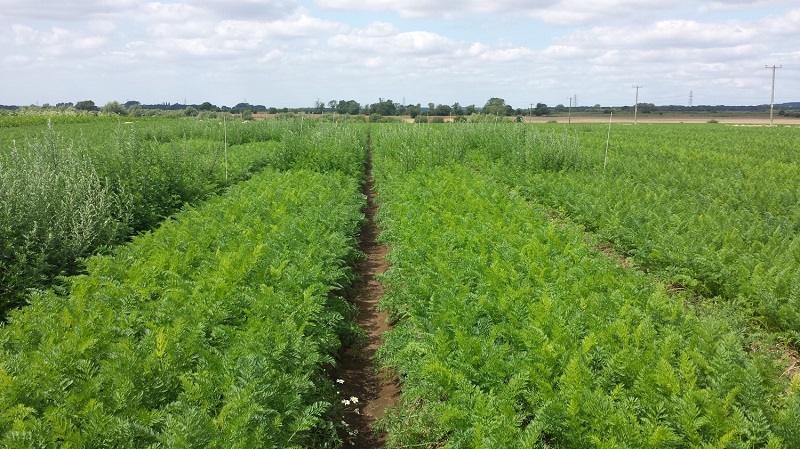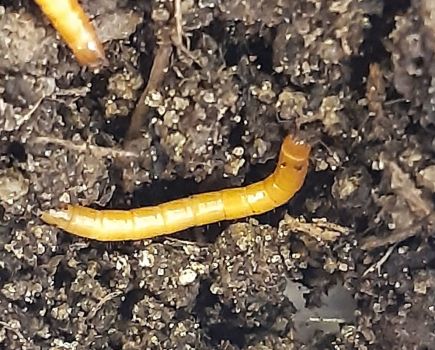There’s a Yorkshire ‘tea’ that’s doing a proper job controlling diseases for one of the UK’s biggest specialist root vegetable grower. CPM finds out more about the brew that may eventually provide a helping hand with late blight control.
Mugwort extract was keeping pace with the better blight chemistry.
By Lucy de la Pasture
The R&D agrochemical companies are constantly screening thousands of molecules before they find one that has potential as a fungicide – it’s an ongoing, costly and high-tech process. That makes the discovery of a potential new fungicide in a parsnip field in Yorkshire all the more remarkable.
A tentative connection between the presence of common mugwort (Artemesia vulgaris) and a lack of disease was first made in 2014 by James Bramley, farm manager at M H Poskitt. While digging parsnips, he noticed that in the weedy patches where mugwort was present that there was no cavity spot, less pest damage and the roots were cleaner than the rest of the crop.
The family-owned farming business is based in the East Riding of Yorkshire and specialises in the growing and packing of root vegetables for supermarket chains. The farm currently produces approximately 80,000 tonnes of crops per year from approximately 2,500ha.
James decided to investigate with the farm’s agronomist, Howard Hinds of Root Crop Consultancy, whether the effects of mugwort were merely a coincidence or a correlation. Their early work involved planting the weed between carrot rows in replicated trials. The result was encouraging, with a significant reduction in the incidence of cavity spot – a disease which costs the veg industry millions of pounds every year.
“Planting mugwort between the rows did cause problems because when it got big, the weed then began to affect the carrot crop,” explains Howard.
So the way the mugwort was brought into contact with the crop evolved and an extract was developed by steeping the weed in hot water to make a ‘mugwort tea’ – a step which then made application possible. The extract was then tried in experiments on different crops and when sprayed onto potato tubers they were found to keep in store for longer. When pumpkin was treated, plants were found to have less disease.
Because of the effect the mugwort had on cavity spot, which was confirmed in testing at John Innes Centre, Howard suggested assessing the leaf extract’s effects on late blight in potatoes, which is also caused by an oomycete pathogen. Samples of the extract were sent to Stockbridge House where it was found to have good activity on late blight. At this point Guy Poskitt came on board to fund independent trials specialists Richard Austen Agriculture to carry out some potato field trials, explains Howard.
The three years of independent trials showed some really positive results, he comments. “The blight pressure was relatively low in the first two years but the mugwort extract was keeping pace with the better blight chemistry. In the last year of trials (in 2019) the blight pressure was high, but the extract still performed very well – although it did lag behind the better blight chemistry under the higher blight pressure.”
Recognising the potential of the extract, the team called on the expertise of Dr Roma Gwynn, director of Rationale, who was first introduced to the farm in her role as AHDB Horticulture board member. Her company specialises in biorational products, with expertise in taking a product from concept to the farmer’s field.
“My role is to streamline the commercialisation process by breaking down the barriers that may be encountered on the way. I can also help with partnerships between innovators and the companies that have the capability to take a concept product to market,” she explains.
Roma worked with James and Howard to progress the project and began to look for a good commercial partnership match.
Roma’s first guidance for the Poskitt team was to get some safety checks done at different times of the year to get an insight on whether the mugwort extract contained any substances that were potentially toxic, recognising this as an important hurdle to get over in the regulatory process.
“The observation and enthusiasm of James and Howard, with the support of Guy, had carried the efficacy work forward but we also needed to know the safety profile as this could have stopped the project in its tracks.”
Samples of the mugwort extract were sent to Bangor University and analysed to identify its constituents. The lab tests found the components had a good safety profile and were mainly terpenoids, which play an important role in natural plant defence mechanisms
With early efficacy and safety data in hand, Roma introduced the Poskitt team to Eden Research, a British company based in Oxfordshire. Eden focuses on sustainable biopesticides and has developed a plastic-free microencapsulation formulation technology.
The companies have shared values and similar ambitions, with both Eden and Poskitt aligned in their belief that the UK agriculture sector requires more sustainable, alternative crop protection products. So Roma thought the companies would be a good fit and that the mugwort discovery may well complement Eden’s existing portfolio of plant-derived biopesticide active ingredients. A partnership agreement was announced just last month.
“We’re delighted to be working with Eden to advance the R&D project, and be working in collaboration with a British company championing sustainable agriculture – particularly as the bar get higher for quality, residue-free produce in supermarkets,” says Guy.
“Following successful results in our initial field trials, we’re excited about potentially finding an alternative treatment to Phytophthora, which remains one of the biggest challenges faced by root vegetable farmers.”
Over the next two years, Eden will be conducting wider testing with the aim of developing a commercially viable product, explains Sean Smith, CEO of Eden Research.
“We’ll build on the initial work that’s been done to characterise the constituents of the mugwort extract and dive deeper to identify all of the compounds within it and those present in meaningful amounts. We’ll then look at ways of maximising their extraction using different techniques and establish the best way to formulate them into a product,” he says.
“We’ll then be in a position to go back into the field with candidate extracts from these enhanced methodologies and the original Poskitt extraction. Replicated trials will be used to establish whether we can replicate or improve upon the performance of the original extract.”
Eden are looking for activity which gives parity with conventional chemistry in order to take the pipeline product forward. The easiest route to market is as a biostimulant but it’s unlikely to be the path followed by the Poskitt/Eden partnership, says Sean.
“Biostimulants don’t have the kind of product profile we’re looking for, so our objective is to produce a product that’s consistent and has gone through the rigour of the regulatory approval process.”
Whether the eventual product registration is as a biopesticide or follows the conventional chemistry route is being evaluated and will likely depend on the ultimate approach to product formulation.
In her role as vice-president of the biocontrol manufacturers association, Roma has a good overview of the industry, which she describes as buoyant and with a projected annual growth of 24%.
“The global trend is to move towards more sustainable agriculture practices and to pay more than lip service to IPM. This is demonstrated in the EU’s Farm to Fork initiative, where any first intervention should now be a biological under its IPM protocols.”
The biocontrol industry has also become an area of interest for investors with a philanthropic interest in sustainable agriculture – a big change from a few years ago when the 10-15 years it can take for a product to reach the market wasn’t proving an attractive proposition for investors, she comments.
The discovery of plants in the field which can be harnessed as biologicals isn’t unusual in the biopesticides world, adds Sean and Roma agrees, saying that it’s an area where farmers are the innovators as much as researchers.
“The challenge for agriculture is to think more as biologists rather than continue to follow the reductionist principles of chemistry. It’s more demanding to manage the complexities of biology but does enable more sustainable production, delivering food to the consumer without damaging the environment,” she comments.
The accelerating loss of conventional active ingredients is highlighted by the recent decision by the EU Standing Committee on Plants, Animals, Food and Feed not to renew approval for mancozeb.
“The loss of mancozeb effectively wipes out almost half of the potato blight chemistry. One of the gaps it leaves will be for alternaria control and although we haven’t tested it yet, the mugwort extract seems to be broad spectrum so may have some activity on early blight,” adds Howard.
One of the benefits of biological extracts is that activity isn’t usually attributable to just one of its constituents and as a result they tend to offer multi-site activity – something that will be largely missing in the potato armoury when mancozeb is no longer available.
Even while Eden take forward the extract, the Poskitt team are continuing to refine their use in the field. “The extract is made in batches so it’s fresh when sprayed, but James has noticed that as the mugwort plants mature, the colour of the extract fluid changes – indicating a probable change in its constituents. That means that for the fresh extract there may be a ‘sweet spot’ in the weed’s development for maximum effect.”




